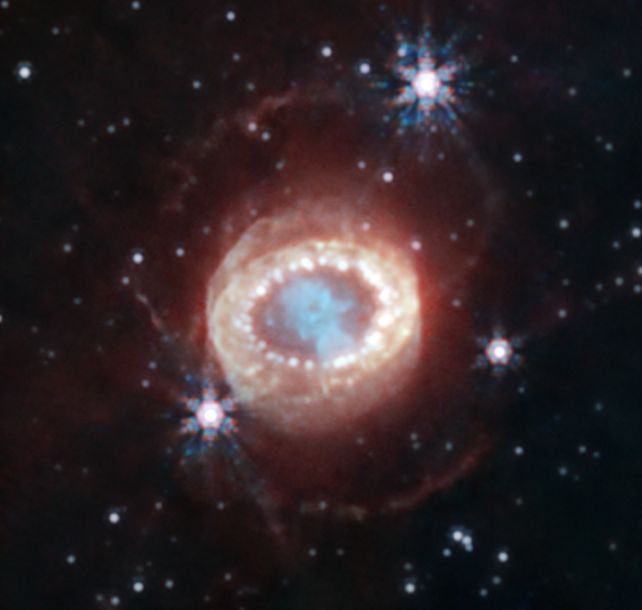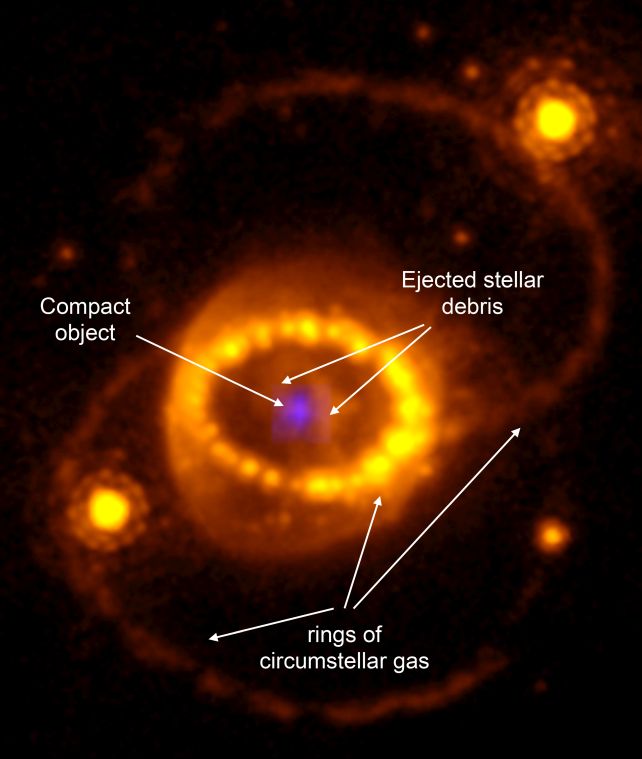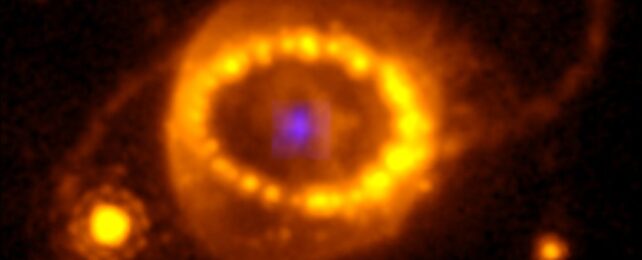In 1987, Earth's sky was lit up by a rare spectacle.
The explosion of light from a dying star going supernova in the Large Magellanic Cloud first became visible in February. Just 168,000 light-years away, the event was so bright it could be seen from the surface of our planet with the naked eye – a pinprick of light that brightened, then faded, over the ensuing months.
Since then, the material ejected during the supernova now named SN 1987A has continued to evolve, no longer visible except through telescopes, but its proximity has given scientists an unprecedented view into the immediate aftermath and evolution of a massive stellar death.
There has, however, been an absolutely glaring question. What happened to the remnant core of the star, the piece of it that should have remained intact in the messy debris of its exploded viscera? Well, we might now have an answer.
Scientists analyzing James Webb Space Telescope (JWST) data have spotted unexpected evidence of a neutron star, lurking amid the stellar detritus.
"Thanks to the superb spatial resolution and excellent instruments on JWST we have, for the first time, been able to probe the center of the supernova and what was created there," says astrophysicist Claes Fransson of Stockholm University, who led the study.
"We now know that there is a compact source of ionizing radiation, most likely by a neutron star. We have been looking for this from the time of the explosion, but had to wait for JWST to be able to verify the predictions."

The core-collapse supernova of a massive star is one of the most violent events in the Universe. These supernovae occur when a hefty star, more than about eight times the mass of the Sun, runs out of material for core fusion.
Once fusion has sputtered to enough of a halt that the outward pressure it produces is no longer sufficient against the inward pressure of gravity, the star goes kablooey.
The outer material is blasted out into space, but the core of the star is squashed inward by gravity into an ultradense object. What this object is depends on the initial mass of the star. Calculations suggest an initial star between around 8 and 30 solar masses will produce a neutron star. Any heavier, and you end up with a black hole.
Because we don't get such a front-row seat to many supernovae, scientists were super enthusiastic to watch it unfold. But, because of all the debris, it was unclear whether SN 1987A resulted in a neutron star or a black hole.
Scientists thought a neutron star was more likely, but have been unable to peer into the dust left behind with high enough resolution to confirm.
JWST took observations of the famous supernova remnant in 2022, and Fransson and his team turned to these to seek answers. They used the powerful telescope's infrared capabilities to peer into the debris, using spectroscopy to analyze the composition of the gas therein.
Around the center of the supernova remnant, close to where the explosion had occurred, they found something surprising: atoms of heavy argon and sulfur whose outer electrons had been stripped, a process known as ionization.
There are multiple avenues for ionization, which entails adding or removing electrons. The team conducted modeling and found that, in this particular context, there was only one explanation: a neutron star.
The team's models returned two neutron star scenarios. In the first, powerful ultraviolet and X-radiation from a very hot neutron star stripped the electrons as the star cooled.
In the second, winds of particles emanating from a rapidly rotating neutron star could have interacted with the surrounding material to ionize the atoms.

"Our detection with James Webb's MIRI and NIRSpec spectrometers of strong ionized argon and sulfur emission lines from the very center of the nebula that surrounds Supernova 1987A is direct evidence of the presence of a central source of ionizing radiation. Our data can only be fitted with a neutron star as the power source of that ionizing radiation," says astronomer Mike Barlow of University College London.
"The mystery over whether a neutron star is hiding in the dust has lasted for more than 30 years and it is exciting that we have solved it."
The discovery is consistent with several theories about neutron stars. Models suggest that argon and sulfur are produced in large quantities inside a dying star just before it goes supernova. And scientists had decades ago predicted that ultraviolet and X-radiation in a supernova remnant represent the presence of a newborn neutron star.
But no one guessed that this might be the way we find it.
"This supernova keeps offering us surprises," says astrophysicist Josefin Larsson of Sweden's Royal Institute of Technology.
"Nobody had predicted that the compact object would be detected through a super strong emission line from argon, so it's kind of amusing that that's how we found it in the JWST."
The discovery has been published in Science.
